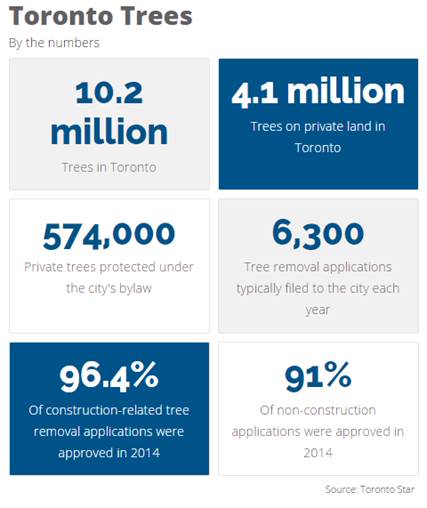
City approval for felling 41 trees rankles golf course neighbours
Scarborough’s Toronto Hunt club wants to install a less pesticide-dependent grass that needs more sunlight.
The Star.com
Feb. 3, 2016
David Rider
Looking from his Scarborough backyard at condemned oak trees in a private golf course, Mark Denington sees a towering double standard.
“If one of those healthy trees were here in my yard, there’s no way in hell the city would let me chop it down so I could have nicer grass,” says the south Scarborough resident.
“But the (Toronto) Hunt golf club gets permission to kill 22 healthy trees? It doesn’t make sense.”
City forestry staff agree a homeowner cannot get such permission. They also defend, despite a community outcry, the decision to grant leafy lakefront Toronto Hunt permission to remove 22 healthy and 19 sickly trees.
So does the local councillor, Gary Crawford, and his colleague Glenn De Baeremaeker, Toronto’s official tree advocate, who warns that jeopardizing the 173-year-old club’s livelihood could mean the loss of many more trees.
“We’re talking 41 trees out of 3,000 on what is a green little gem — they’re not raping and pillaging the land,” De Baeremaeker said. “If the club’s not viable, you will see multi-million-dollar condos there, and, for those trees, it will be a chainsaw massacre.”
The historic club, with more than 800 members, is installing bentgrass around the second and third holes.
The variety requires less pesticide to maintain, says property manager Scott Heron, but more sunlight than the canopy allows. Eventually there should be bentgrass on all nine holes, but further mass tree removals are not planned, he said.
Club general manager Chris Neale acknowledged some members are unhappy with the tree removal, but said it must be done.
Toronto Hunt originally wanted to remove 200 trees. The number dropped to 41 after discussions with city forestry staff and a meeting that included Crawford. The club has agreed to plant 285 new trees on the 100-acre site.
Denington said he is afraid the “clear cut” is just the start.
He learned of the removal from a neighbour, who spied a notice near the club gate. City staffers did not want community input, he says, and refused to divulge details, including the plan that shows the location of the condemned trees.
“How can you fight something if you don’t know what it what says?”
Arthur Beauregard, the city’s manager of urban forestry tree protection, acknowledged that Denington’s questions could have been handled better.
He said most tree-removal applications, both residential and construction-related, are approved.
For construction projects, the city approves healthy tree removal if it's necessary to complete the project as zoned.
“Our attempt and our intent is to have the same line for anybody,” based on expert analysis and criteria in the bylaw aimed at preserving as many trees as possible, he said.
Councillor Sarah Doucette, formerly the city’s official tree advocate, is not so sure.
“With healthy trees we should be more proactive protecting them,” she said.
The Hunt oaks will be felled as early as Feb. 17.

